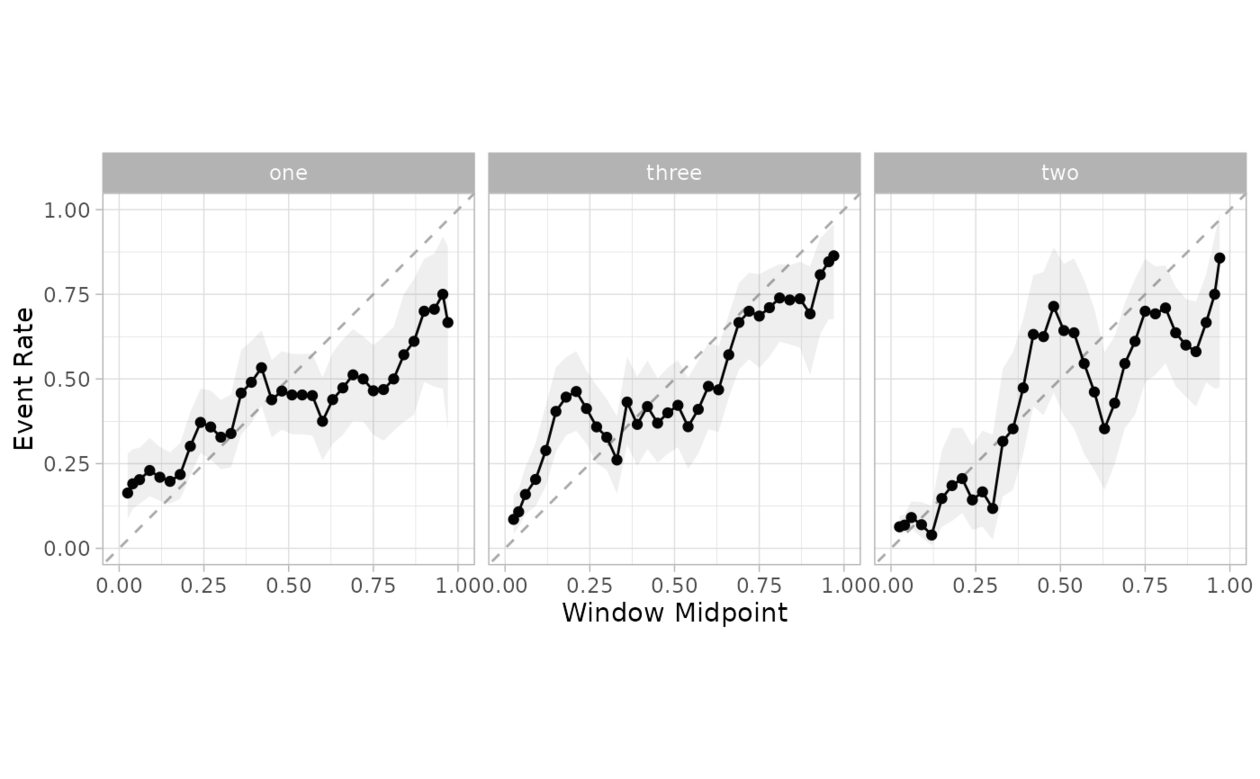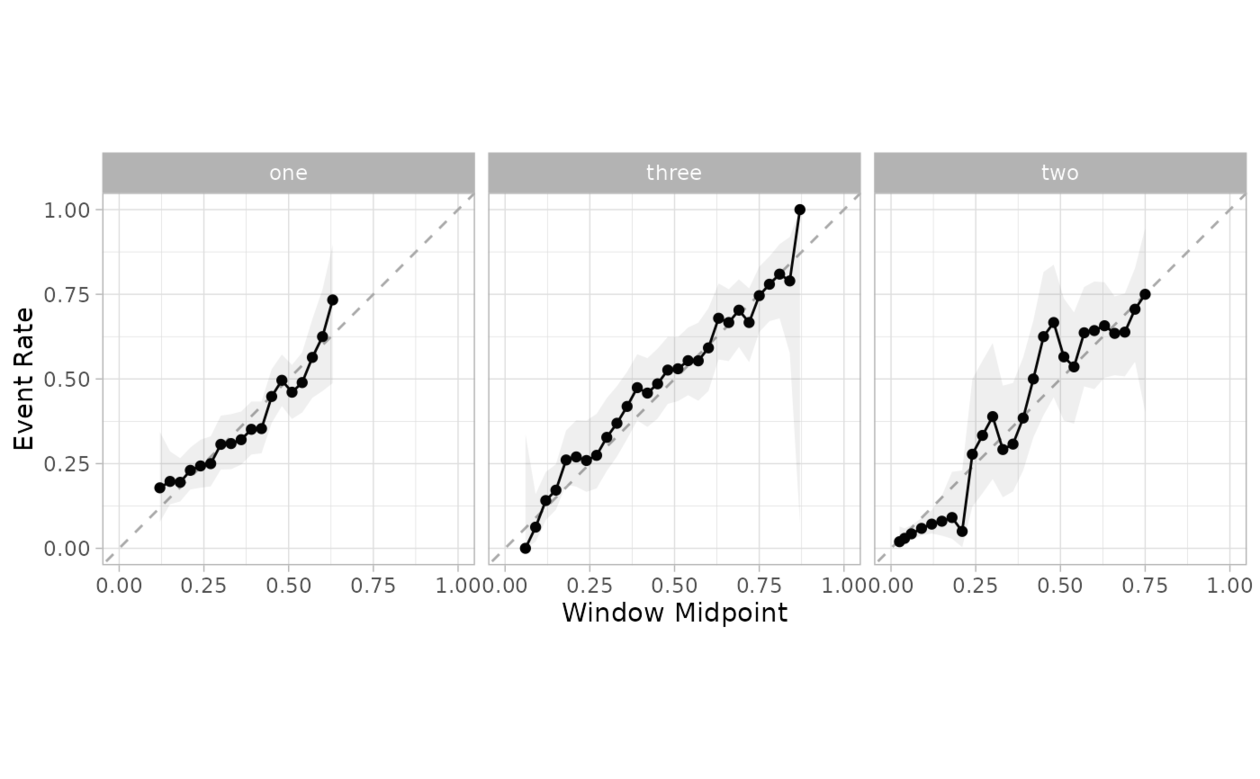使用多项校准模型来计算新的概率
用法
cal_estimate_multinomial(
.data,
truth = NULL,
estimate = dplyr::starts_with(".pred_"),
smooth = TRUE,
parameters = NULL,
...
)
# S3 method for data.frame
cal_estimate_multinomial(
.data,
truth = NULL,
estimate = dplyr::starts_with(".pred_"),
smooth = TRUE,
parameters = NULL,
...,
.by = NULL
)
# S3 method for tune_results
cal_estimate_multinomial(
.data,
truth = NULL,
estimate = dplyr::starts_with(".pred_"),
smooth = TRUE,
parameters = NULL,
...
)
# S3 method for grouped_df
cal_estimate_multinomial(
.data,
truth = NULL,
estimate = NULL,
smooth = TRUE,
parameters = NULL,
...
)参数
- .data
-
未分组的
data.frame对象或tune_results对象,包含预测和概率列。 - truth
-
真实类别结果的列标识符(即一个因子)。这应该是一个不带引号的列名。
- estimate
-
列标识符向量,或
dplyr选择器函数之一,用于选择哪些变量包含类概率。它默认为 tidymodels 使用的前缀 (.pred_)。标识符的顺序将被视为与truth变量的级别顺序相同。 - smooth
-
适用于物流模型。当
TRUE时,它在逻辑样条曲线之间切换;当FALSE时,它在简单逻辑回归之间切换。 - parameters
-
(可选)可选的调整参数值小标题,可用于在处理之前过滤预测值。仅适用于
tune_results对象。 - ...
-
传递给用于计算新概率的模型或例程的附加参数。
- .by
-
分组变量的列标识符。这应该是一个不带引号的列名称,用于选择用于分组的定性变量。默认为
NULL。当.by = NULL时,不会进行分组。
细节
当smooth = FALSE时,使用nnet::multinom()函数来估计模型,否则使用mgcv::gam()。
例子
library(modeldata)
library(parsnip)
library(dplyr)
f <-
list(
~ -0.5 + 0.6 * abs(A),
~ ifelse(A > 0 & B > 0, 1.0 + 0.2 * A / B, -2),
~ -0.6 * A + 0.50 * B - A * B
)
set.seed(1)
tr_dat <- sim_multinomial(500, eqn_1 = f[[1]], eqn_2 = f[[2]], eqn_3 = f[[3]])
cal_dat <- sim_multinomial(500, eqn_1 = f[[1]], eqn_2 = f[[2]], eqn_3 = f[[3]])
te_dat <- sim_multinomial(500, eqn_1 = f[[1]], eqn_2 = f[[2]], eqn_3 = f[[3]])
set.seed(2)
rf_fit <-
rand_forest() %>%
set_mode("classification") %>%
set_engine("randomForest") %>%
fit(class ~ ., data = tr_dat)
cal_pred <-
predict(rf_fit, cal_dat, type = "prob") %>%
bind_cols(cal_dat)
te_pred <-
predict(rf_fit, te_dat, type = "prob") %>%
bind_cols(te_dat)
cal_plot_windowed(cal_pred, truth = class, window_size = 0.1, step_size = 0.03)
 smoothed_mn <- cal_estimate_multinomial(cal_pred, truth = class)
new_test_pred <- cal_apply(te_pred, smoothed_mn)
cal_plot_windowed(new_test_pred, truth = class, window_size = 0.1, step_size = 0.03)
smoothed_mn <- cal_estimate_multinomial(cal_pred, truth = class)
new_test_pred <- cal_apply(te_pred, smoothed_mn)
cal_plot_windowed(new_test_pred, truth = class, window_size = 0.1, step_size = 0.03)

相关用法
- R probably cal_estimate_beta 使用 Beta 校准模型来计算新概率
- R probably cal_estimate_isotonic 使用等渗回归模型来校准模型预测。
- R probably cal_estimate_logistic 使用逻辑回归模型来校准概率
- R probably cal_estimate_isotonic_boot 使用引导等渗回归模型来校准概率
- R probably cal_estimate_linear 使用线性回归模型来校准数值预测
- R probably cal_plot_logistic 通过逻辑回归绘制概率校准图
- R probably cal_plot_breaks 通过分箱绘制概率校准图
- R probably cal_validate_logistic 使用和不使用逻辑校准来测量性能
- R probably cal_validate_isotonic_boot 使用和不使用袋装等渗回归校准来测量性能
- R probably cal_plot_regression 回归校准图
- R probably cal_validate_multinomial 使用和不使用多项式校准来测量性能
- R probably cal_apply 对一组现有预测应用校准
- R probably cal_validate_linear 使用和不使用线性回归校准来测量性能
- R probably cal_plot_windowed 通过移动窗口绘制概率校准图
- R probably cal_validate_isotonic 使用和不使用等渗回归校准来测量性能
- R probably cal_validate_beta 使用和不使用 Beta 校准来测量性能
- R probably class_pred 创建类别预测对象
- R probably append_class_pred 添加 class_pred 列
- R probably threshold_perf 生成跨概率阈值的性能指标
- R probably as_class_pred 强制转换为 class_pred 对象
- R probably levels.class_pred 提取class_pred级别
- R probably locate-equivocal 找到模棱两可的值
- R probably int_conformal_quantile 通过保形推理和分位数回归预测区间
- R probably make_class_pred 根据类概率创建 class_pred 向量
- R probably reportable_rate 计算报告率
注:本文由纯净天空筛选整理自Max Kuhn等大神的英文原创作品 Uses a Multinomial calibration model to calculate new probabilities。非经特殊声明,原始代码版权归原作者所有,本译文未经允许或授权,请勿转载或复制。
